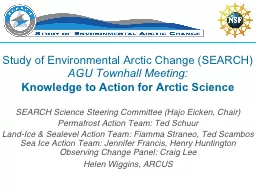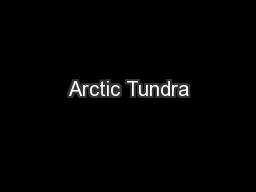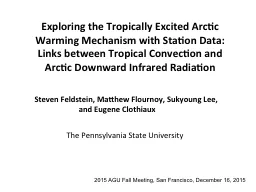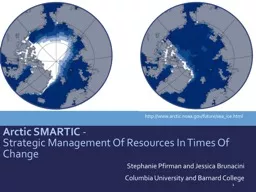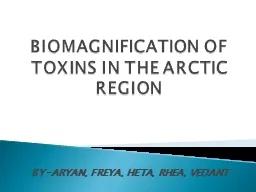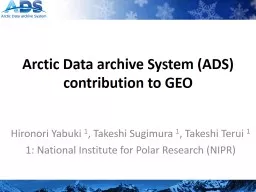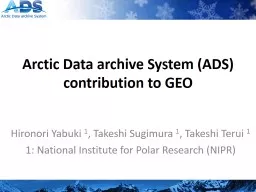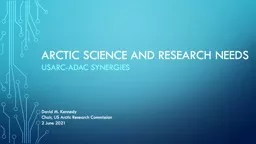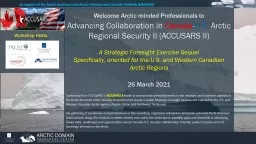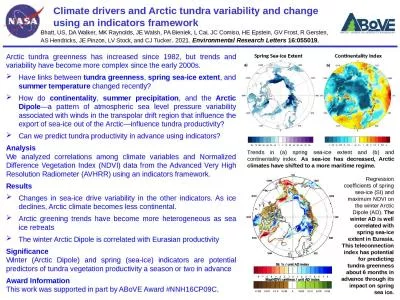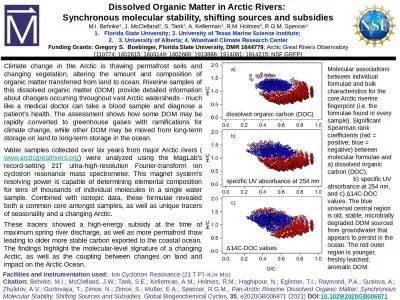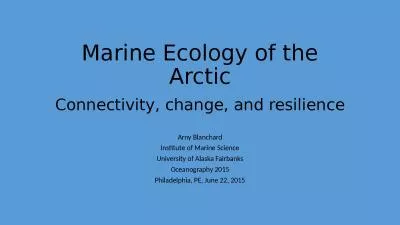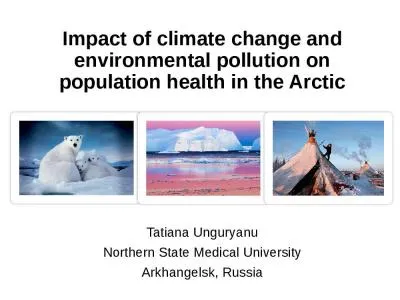PPT-Study of Environmental Arctic Change (SEARCH)
Author : jewelupper | Published Date : 2020-07-01
AGU Townhall Meeting Knowledge to Action for Arctic Science SEARCH Science Steering Committee Hajo Eicken Chair Permafrost Action Team Ted Schuur LandIce amp
Presentation Embed Code
Download Presentation
Download Presentation The PPT/PDF document "Study of Environmental Arctic Change (S..." is the property of its rightful owner. Permission is granted to download and print the materials on this website for personal, non-commercial use only, and to display it on your personal computer provided you do not modify the materials and that you retain all copyright notices contained in the materials. By downloading content from our website, you accept the terms of this agreement.
Study of Environmental Arctic Change (SEARCH): Transcript
AGU Townhall Meeting Knowledge to Action for Arctic Science SEARCH Science Steering Committee Hajo Eicken Chair Permafrost Action Team Ted Schuur LandIce amp Sealevel Action Team . 25th Oct 13 2013 International Territory of Svalbard In 2013 The Arctic Circle program embarks on two h igh Arctic expeditions aboard an iceclass expedition sailing vessel International artists of all disciplines architects scientists and educators By . Zoie. . V.. An Arctic fox is a mammal because it has at least one hair on its body.. An Arctic Fox Is . A. . M. ammal. White and blue/gray.. What Color Is Your Animal. Arctic foxes live in dens.. By: Kevin, Hayley, and Caroline. Northern Hemisphere. Falls between 2 biomes: . Taiga. and the . Ice Caps. Global Locations. Artic Tundra Food Web. 6-10 inches yearly (mostly snow). Summer. : sun 24/7 (3-12 degrees Celsius). Steven Feldstein, Matthew . Flournoy. , . Sukyoung. Lee,. and Eugene . Clothiaux. The Pennsylvania State University. 2015 AGU Fall Meeting, San Francisco, December 16, 2015. (2) eastward acceleration at the wave source; if strong enough, generates equatorial . Stephanie . Pfirman. and Jessica . Brunacini. Columbia University and Barnard College. 1. http://. www.arctic.noaa.gov. /future/. sea_ice.html. Loss of Summer Sea Ice. 2. Seasonal Variations In Sea Ice. BY-ARYAN, FREYA, HETA, RHEA, VEDANT . WHAT IS BIOMAGNIFICATION. HOW DOES BIOMAGNIFICATION IMPACT US. BIOMAGNIFICATION AND THE CURRENT EFFECT IN ARCTIC. CASE STUDY 1. CASE STUDY 2. Why is Arctic important. contribution to GEO. Hironori . Yabuki. . 1. , Takeshi Sugimura . 1. , Takeshi Terui . 1. 1: National Institute for Polar Research . (. NIPR). Arctic Data . Archive System. Purpose of The Arctic Data Archive. contribution to GEO. Hironori . Yabuki. . 1. , Takeshi Sugimura . 1. , Takeshi Terui . 1. 1: National Institute for Polar Research . (. NIPR). Arctic Data . Archive System. Purpose of The Arctic Data Archive. USARC-ADAC Synergies. David M. Kennedy. Chair, US Arctic Research Commission. 2 June 2021. US Arctic Research Commission:. • Develops national Arctic research policy. • Facilitates Arctic research coordination . Advancing Collaboration in . Canada. -. U.S.. . Arctic . Regional Security II (ACCUSARS II) . A Strategic Foresight Exercise Sequel . Specifically, oriented for the U.S. and Western Canadian Arctic Regions. Arctic tundra greenness has increased since 1982, but trends and variability have become more complex since the early 2000s. . Have links between . tundra greenness. , . spring sea-ice extent. , and . Water samples collected over six years from major Arctic rivers (. www.arcticgreatrivers.org. ) were analyzed using the MagLab’s record-setting 21T ultra-high-resolution Fourier-transform ion cyclotron resonance mass spectrometer. This magnet system’s resolving power is capable of determining elemental composition for tens of thousands of individual molecules in a single water sample. Combined with isotopic data, these formulae revealed both a common core amongst samples, as well as unique tracers of seasonality and a changing Arctic. . Connectivity, change, and resilience. Arny Blanchard. Institute of Marine Science. University of Alaska Fairbanks. Oceanography 2015. Philadelphia, PE, . June 22, . 2015. http://. fortunedotcom.files.wordpress.com/2012/05/barrow_alaska_tundra.jpg. Tatiana Unguryanu. Northern State Medical University. Arkhangelsk, Russia. Major human-health implications of climate change. 2. Climate . change. Impact on a human. Regional . weather changes. Warm waves.
Download Document
Here is the link to download the presentation.
"Study of Environmental Arctic Change (SEARCH)"The content belongs to its owner. You may download and print it for personal use, without modification, and keep all copyright notices. By downloading, you agree to these terms.
Related Documents

